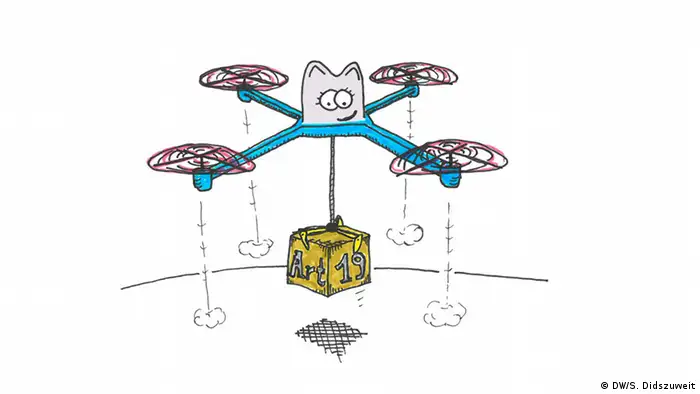In focus
Breaking boundaries
Drones are being used for a variety of activities from delivering parcels to military surveillance. A journalist in Kenya has tested them out for covering news stories in new and exciting ways.
In Kenya, journalists face many obstacles trying to cover stories, ranging from a lack of infrastructure to difficulties in reaching places where news is unfolding.
Journalist Dickens Olewe had always had a fascination with drones and their potential for transforming Kenya's media landscape. His idea was put to the test when he won the African News Innovation Challenge 2012 to explore whether drones could be a digital solution to some of these challenges.
Thus African SkyCAM was born with a grant of $50,000 to test whether drones could be used to reach the unreachable: to capture uncaught footage and to provide journalists with a reporting tool that not only enables better quality storytelling but also pushes the boundaries of visual imagery, thereby creating new ways for people to access information.
Inception
Olewe came up with the idea of using drones when he was reporting on floods in Kenya. He realized there were only two ways of shooting footage in affected areas; hitching a lift with a military helicopter or going out in the often rickety boats of local fishermen. Both options had drawbacks. Flying over the floods with the military meant he only got to see what the military wanted him to see, while going out with the fishermen was a risky endeavor. All in all, attaching a camera to a drone seemed like an obvious solution to capturing independent footage and staying safe at the same time.
Technical challenges
After being accepted for the News Challenge, Olewe read everything he could about drones but he had never handled one himself. Luckily, a fellow journalist who was a bit of a drone hobbyist agreed to help with the project. It soon became apparent, however, that they needed more expertise. Through the drone community, Olewe was put in contact with the American drone expert, Ben Kreimer, who agreed to come to Kenya to train Olewe and his team, and be part of the African SkyCAM experiment.
“I started out doing two things,” Olewe remembers. “One was obviously the big step of doing ambitious projects with Ben doing most of the flying and I doing most of the strategy and the producing. And then teaching the guys how to use the equipment. And I have to say it worked well.”
Olewe says flying a drone isn't that difficult once you’ve got the hang of it. But given the nature of a drone journalism story, safety is paramount. “If you are not a seasoned flier you might end up crashing,” he warns.
“This can be really dangerous and cause injury. We are flying around people and I didn’t want to risk trying to fly and having someone with just a little bit of experience covering the story. I put safety first.”
Exciting footage
The most technologically advanced story covered by the African SkyCam team was to shoot drone footage of Nairobi's Dandora dump site, and use this to create a 3D model of the rubbish dump.
The dump, which was initially supposed to be temporary, has displaced people and housing, Olewe explains. “It is insecure as there are now schools and houses in the dump site, so there are loads of social issues. The community has even gone to court to ask the government to relocate the dump.”
“So we have a very good 3D model of this site and it is fascinating for the media to have this and to have these kinds of stories,” he says.
African SkyCAM was also able to partner with CCTV Africa to cover a conservation project on elephant and rhino poaching, managing to capture footage of these animals in their natural habitat. They also reported on cultural and political events such as a car rally in the countryside outside of Nairobi and a political rally attended by thousands of people.
The African SkyCAM project demonstrates that drone journalism can push the boundaries of reporting and capturing footage in Africa. It also illustrates how drones armed with cameras can be used by a variety of actors to cover a wide range of public interest stories.
By using drones for reporting, African SkyCAM has created new avenues for access to information. The visual elements helped transform the stories and gave them a new edge that the audience liked. By providing imagery from a new perspective, they were able to capture people's imagination and attention, and share information in a way that reached more people.
Regulatory limits
The African SkyCAM team didn't encounter any regulatory issues carrying out their project: they had no difficulties in receiving permits or police permission to shoot footage.
However, the situation has since changed in Kenya. In January 2015, Kenyan authorities regulated against the civilian use of drones, deeming the potential for misuse, abuse and terrorist attacks too high to be legally permissible.
This has meant the end of African SkyCAM. Nevertheless, Olewe remains true to drone journalism. In order to explore the opportunities drones offer, he is supporting drone journalism in other parts of the world. As a John S. Knight Fellow at Stanford, he organized a conference that brought together drone manufacturers, academics and lawyers to discuss the future of drones.
“I intend to organize a similar event in Africa to kick-start the conversation on regulating innovation,” Olewe says. “I think this approach is key in ensuring that we open up the operation space and also shape the policy conversation.”
Author: Roslyn Kratochvil Moore
DW recommends
WWW links
- Date 15.03.2016
- Author Roslyn Kratochvil Moore
- Feedback: Send us an e-mail. Please include your name and country in your reply.
- Print Print this page
- Permalink https://p.dw.com/p/1ICzL
- Date 15.03.2016
- Author Roslyn Kratochvil Moore
- Send us your feedback.
- Print Print this page
- Permalink https://p.dw.com/p/1ICzL

